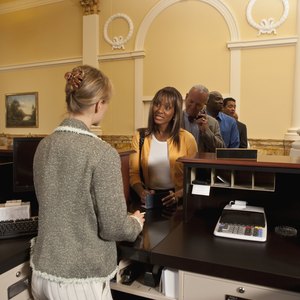
Folks don’t use checks as much as they used to. The Federal Reserve conducted a study and found that 30.5 billion checks were processed in 2006, reports Bankrate.com. In three years, that amount dropped to 24.5 billion. But checks aren’t likely to disappear anytime soon. They’re still beneficial in many situations. You might receive checks from friends, employers or even unsolicited in the mail -- those could be fraudulent -- so it’s useful to understand what happens after you cash a check.
How to Cash
Most people cash checks by depositing them into their bank accounts. After depositing the check, you receive the cash. It typically varies regarding how quickly the funds are available to you depending on the type of check you cash and whether you cash it at a branch or an ATM. You usually get the cash within a day or two. If you don’t have a bank account, you can cash a check at a check-cashing store or at the bank that issued the check, but you pay a fee to do so.
Clearinghouse
After you deposit your check, the bank encodes the amount onto the check into text that a machine can read. The check goes through a machine that takes a picture of the front and back of the check to make an electronic file of it. The file is sent to a clearinghouse that sorts checks to send to the banks against which the checks are drawn. When the bank receives the data file from the check you cashed, it matches the data to its customer who wrote the check.
Checks Clearing
If the customer who wrote you the check has the funds in his account, you are paid. The bank holds the original check anywhere from a few weeks to a few months and then shreds it. You get the electronic file, called the image replacement document, to keep for your records. The Check 21 Act, a federal law passed in 2004, made electronic processing legal. Before that, you would receive your original check back with your bank statement every month. Some banks don’t require you to bring the physical copy of the check to cash it. If you have the bank’s smartphone application, you usually can take a picture of the check with your smartphone and send it to the bank for processing.
Checks Bouncing
If the customer who wrote you the check doesn’t have the funds or if he’s placed a stop payment on the check, the electronic file of the check is flagged. It is then sent back to the bank you used to deposit the check. You would then get the original check back, and the back would take back its money. You need to go back to the person who issued the check to be paid. The check that was returned to you is called a “bounced” check. About 127 million checks bounced in 2009.
Check Scams
People who send you a check but ask you to wire money back after you cash it are likely conning you. There is no legitimate reason for anyone to do this, according to the Credit Union of Colorado. The bank might not discover there was a problem with the check for weeks. Meanwhile, you received the money. The bank holds you responsible for the money it lost, so it deducts the funds from your account. If you don’t have enough funds in your account, the bank might sue you for the money.
References
- Bankrate.com: What Happens When You Write a Check?
- U.S. News Money: How to Cash a Check Without a Bank Account
- ColoradoLegalServices.org: What you Should Know about Writing Checks
- Credit Union of Colorado: Fake Check Scams
- Consumer Financial Protection Agency. "How Quickly Can I Get Money After I Deposit a Check Into My Checking Account? What Is a Deposit Hold?" Accessed March 30, 2020.
- HelpWithMyBank.gov. "Answers About Funds Availability." Accessed March 30, 2020.
- HG.org. "Consequences of Writing a Bad Check." Accessed March 30, 2020.
- Bank of America. "Financial Center FAQs." Accessed March 30, 2020.
- HelpWIthMyBank.gov. "Answers About Overdraft/NSF Fees and Protection." Accessed March 30, 2020.
- Kmart. "Check Cashing." Accessed March 30, 2020.
- Consumer Financial Protection Bureau. "Can a Bank or Credit Union Cash a Post-Dated Check Before the Date on the Check?" Accessed March 30, 2020.
Writer Bio
Laura Agadoni has been writing professionally since 1983. Her feature stories on area businesses, human interest and health and fitness appear in her local newspaper. She has also written and edited for a grassroots outreach effort and has been published in "Clean Eating" magazine and in "Dimensions" magazine, a CUNA Mutual publication. Agadoni has a Bachelor of Arts in communications from California State University-Fullerton.

